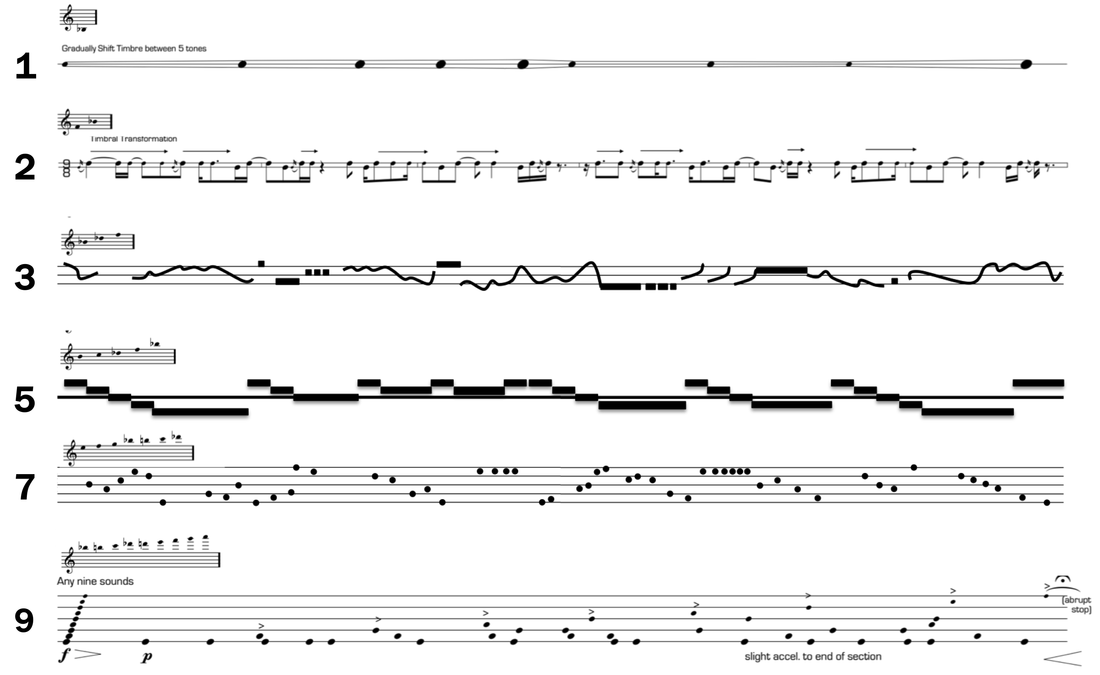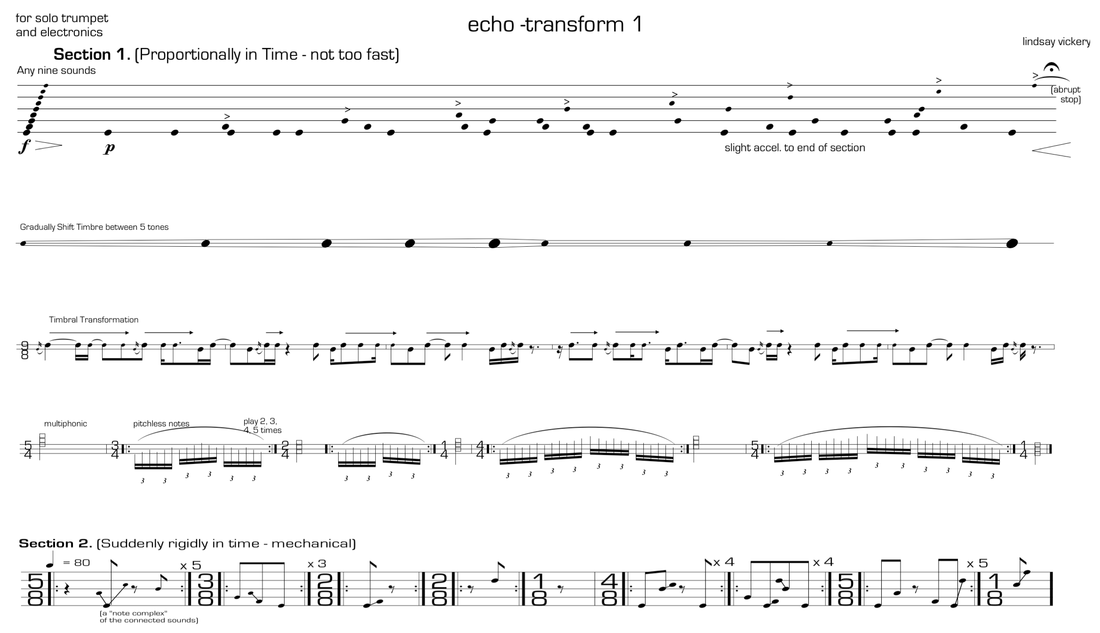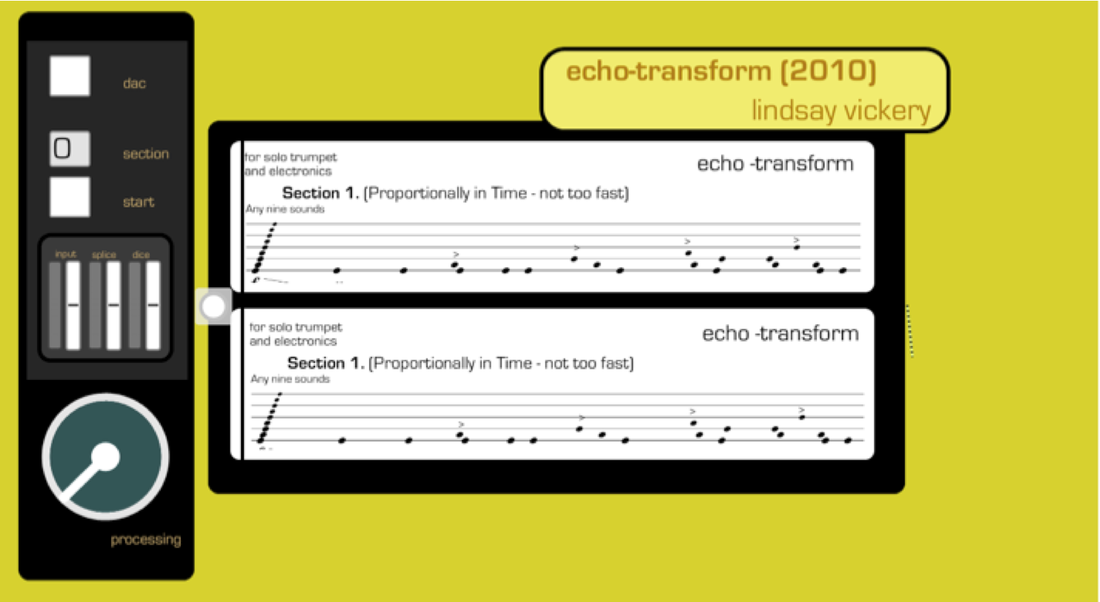2010
115 Improbable Games [2010] alto flute, clarinet, cello and electronics 9-11m
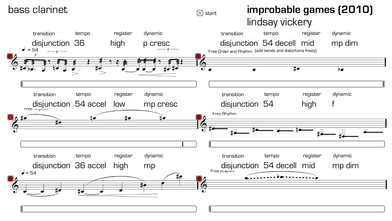
Improbable Games explores the distinction between passages of notated, pulsed synchronous material and semi-improvisatory, unpulsed asynchronous material. The synchronous materials comprise 27 bars of notated score derived from the work Kreuz des Suedens, divided into three segments of nine, ten and eight bars respectively, that are contrasting in tempo, register dynamic and texture. The asynchronous passages consist of the same 27 bars presented individually to the performers in indeterminate order. To the left is a screenshot of the screenscore of Improbable Games. The performers are expected to explore this fragmented material over a period of time (between 1 and 27 seconds) indicated by the left to right movement of a scroll-bar below the fragment.
The synchronous passages emerge from this asynchronous texture as a “full-screen” linear score, together with a clicktrack to coordinate the performers. The actual iteration of the formal structure is altered in each performance. The piece concludes when all three synchronous passages and all 27 asynchronous passages have been performed. A schematic representation of a possible instantiation of the formal structure of Improbable Games is shown below.
|
The work uses a combination of permutation and continuity through the presentation of the materials via a screen-score. The implications of this formal arrangement are both nonlinear in any particular instantiation, and in respect to variation between repeated performances. To the left is a video explaining the score.
Performances:
20101201 Decibel, CreateWorld 2010, Griffith University, Queensland 20101203, Decibel, MSA Conference, University of Otago, Dunedin New Zealand 20110128 Decibel, Kalyenup Studio, Albany Entertainment Centre, Albany 20110129 Decibel, Karri View Winery, Denmark 20110130 Decibel, Painted Tree Gallery, Northcliffe 20110131 Decibel, Nannup Town Hall, Nannup 20110514 Decibel, Peking Spring, New Music Network, Street Theatre ANU, Canberra 20110515 Decibel, New Music Network, East Wing Theatre, Sydney Conservatorium, Sydney |
|
114 ghosts of departed qualtities [2010] bass flute, bass clarinet, cello, piano and electronics 10
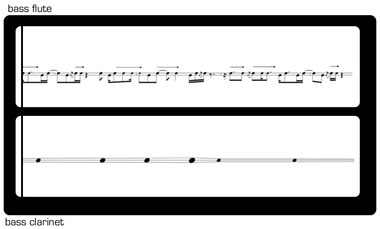
ghosts of departed quantities explores the paradox of “the devil’s staircase”, in which the proportional removal of material is repeated successively, leading to the formation of an increasing number of fragments of decreasing size. The work takes title from George Berkeley’s The Analyst (1734): “And what are these same evanescent Increments? They are neither finite Quantities nor Quantities infinitely small, nor yet nothing. May we not call them the Ghosts of departed Quantities?”.
The four performers - bass flute, bass clarinet, cello and piano - are presented with a networked, graphically notated, permutated and scrolling score as shown on the left.
|
The graphical score comprises six sections each with a pitch set of 1, 2, 3, 5, 7 or 9 pitches, derived from the harmonic series of Bb (left).
The performers read the notation as it scrolls across their screen. Tempo variation is implied by five different scroll speeds. The sections and scroll speeds are permutated by the computer. The work progresses in 60-second blocks. In each successive block the score is withdrawn from the screen for increasingly short, but increasingly frequent periods. The progression of this process is illustrated in to the below. Listen here. |
113 In the Dark (for the dance work by Bianca Martin) [2010] CD 12m
Performances:
20100617 Bianca Martin, In the Dark, Perth Institute of Contemporary Arts, Perth
20100617 Bianca Martin, In the Dark, Perth Institute of Contemporary Arts, Perth
112 delineate 1 [2010] instrument and electronics 6m
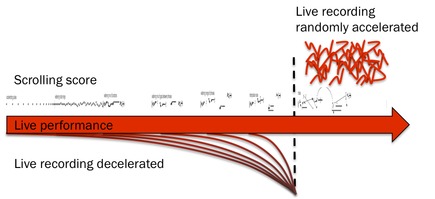
Delineate is a solo work in which the performer reads a continuously scrolling score, with a developmental narrative quality of increasing complexity. As the work progresses, the soloist’s performance is recorded and simultaneously played back at an increasingly slower rate and therefore lower pitch. At the beginning of each new section, another recording and decelerating playback is added until the final section. In the final improvised section, a seven-note polyphonic accompaniment is created by suddenly playing the recorded sound-files back at random times and with glissandi created by fluctuating playback speeds. The figure to the left shows a schematic representation of the formal structure of delineate. Listen here.
|
Performances:
20100515 Lindsay Vickery, Transformations, Sound Unbound, KK Gallery ECU, Perth |
|
111 echo-transform 1 [2010] instrument and electronics 9m
|
echo transform combines the improvisation and sampling procedures of Splice, with a graphically notated and permutated scrolling screen-score. The score elements (shown to the right), indicate relative pitch and duration, and is interpreted by the performer in semi-improvisatory fashion as it scrolls across the computer screen. the sampling process is visually ‘opaque’ to the performer (there is no visual sign that it is taking place and it is not notated in the score). However, due to the increased consistency of the process, (the computer will always reliably sample the same portions of the performance), the players can begin, through repeated rehearsal, to recognize aspects of the process aurally.
|
|
In echo-transform, the score is “permutated” in the sense that it can jump from section to section in any order. The sections also scroll at a range of different speeds. There are five mobile sections in echo-transform and an introductory and closing section. Each mobile section uses only 1, 2, 3, 4 or 5 “notes”, however the actual kind of sound that is rendered as a “note” is not specified. In is intended that the performer create a new combination of sounds each time the score appears, and if appropriate, links their note choice to the previous section. Electronic processing is linked to each section so that the sound environment for each section is similar whenever it is played. The score is presented to the performer on screen, with two staves that alternate allowing the performer to see what section will occur next as shown to the left. Listen here.
|
Performances:
20100515 Lindsay Vickery, Transformations, Sound Unbound, KK Gallery ECU, Perth
20100515 Lindsay Vickery, Transformations, Sound Unbound, KK Gallery ECU, Perth


